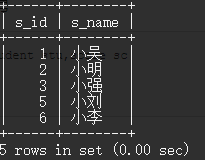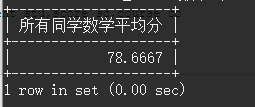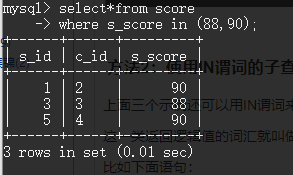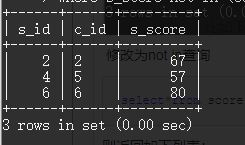MySQL数据库学习记录:基本操作
作业练习:
创建表
–(1)学生表
Student(s_id,s_name,s_age) --学生编号,学生姓名,学生年龄
–(2) 课程表
Course(c_id,c_name) – --课程编号, 课程名称
–(3) 成绩表
Score(s_id,c_id,s_score) --学生编号,课程编号,分数
语句如下:

添加信息
-------------(使用insert批量插入语句时,不同行用逗号隔开)-------------
向student表中批量插入信息
insert into student(s_id,s_name,s_age)values(1,'小吴',13),(2,'小明',14),(3,'小强',23),(4,'小齐',18),(5,'小刘',17),(6,'小李',20);
向course表中批量插入信息
insert into course(c_id,c_name) values (001,'语文'),(002,'数学'),(003,'英语'),(004,'化学'),(005,'物理'),(006,'物理');
向score表中批量插入信息
insert into score(s_id,c_id,s_score) values (1,2,90),(2,2,67),(3,3,88),(4,5,57),(5,4,90),(6,6,80);
显示表内容:
如需显示表内容,用select *from 表名 where 条件;自己查找即可
接下来的查询皆是由此衍生出来的
练习mysql语句:
1.查询年龄在15岁至21岁的同学信息
select *from student where s_age>15 and s_age<21;

2.查询成绩大于60的同学的名字和学号
select stu.s_id,stu.s_name from student stu,score sc where stu.s_id=sc.s_id and sc.s_score>60;

3.查询选了“数学”的课程的所有同学的平均成绩
select AVG(sc.s_score) from student stu,score sc,course co '所有同学数学平均分' where stu.s_id=sc.s_id and co.c_name='数学';

方法2:使用IN谓词的子查询
上面三个示例还可以用IN谓词来查询,首先解释下何为谓词,通常我们用的>、<、and、or、is null、is not null、in、not in等逻辑词返回的结果都是true,false和不确定。
这一类返回逻辑值的词汇就叫做查询的谓词,而IN谓词也是其中一种,表示是否包含其中。
比如下面语句:
select*from score where s_score in (88,90);
该语句的意思是,判断列属性s_score 中列值为88和90的所有行值。

修改为not in查询
select*from score where s_score not in (88,90);
则返回下列内容:即不是88,90的行内容。

好了,到这里对IN子查询的铺垫已完成
我们进入正题,讨论下嵌套select的IN子查询。
先看下执行语句;
1.查询年龄在15岁至21岁的同学信息: select s_id,s_name from student where 15<s_age<20; 2.查询成绩大于60的同学的名字和学号: select s_id,s_name from student where s_id IN (select s_id from score where s_score>60); 3.查询选了“数学”的课程的所有同学的平均成绩: select AVG(s_score) from score where c_id IN (select c_id from course where c_name='数学');
即在IN后面又进行了一次查询,我们把后面的语句返回的结果作为一个类似于上述(80,90)的列表就好理解了。
返回结果见 ↑连表查询。



 浙公网安备 33010602011771号
浙公网安备 33010602011771号